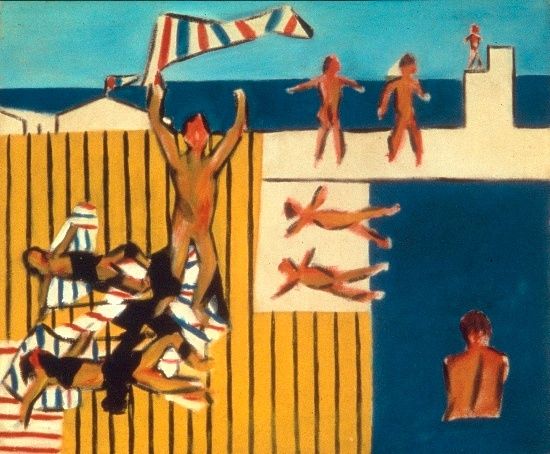

Bathers, 1943
Sidney Nolan Bathers 1943 enamel on canvas 64 x 76.5 cm Heide Museum of Modern Art, Melbourne Bequest of John and Sunday Reed 1982
Lesley Harding is Curator at Heide Museum of Modern Art
"Born and raised in Melbourne’s bayside suburb of St Kilda, Sidney Nolan often drew on familiar subjects and motifs such as the local swimming baths, foreshore, pier and eponymous fairground, Luna Park, as the subjects for his artistic investigations. Bathers, one of several memory-based works on this otherwise classical theme, captures the heat, haze and spirit of the Australian summer in typically laconic style.
The flattened picture plane and disjunctive scale of Bathers pays homage to the work of cubist and purist painter Fernand Léger. This is most obvious in the abbreviated details of the picture: the black outlines, tricolour towels and flag, and the exaggerated stripes of the slatted platform. Similarly the reductive spatial compositions of Mondrian can be found in the painting’s structure; take the figures away and the pier, decking, sea and sky become a constructive geometric abstraction in panes of barely modulated colour. However Nolan had already been experimenting with perspective and form in his paintings of the Wimmera district, with which Bathers chronologically coincides.
In 1942 he abandoned the abstract idiom he had hitherto pursued, and turned his attention to the stories and distinctive aesthetic of his Australian context. He had been conscripted into the army in April and stationed in north-western Victoria’s vast wheat belt. With ample time to paint, a period of great advancement in his work commenced—he adapted and expanded upon recent developments in international modernism and applied them to the local setting. It has been said that Nolan’s paintings from this time helped transform the way Australians envisaged their native land.
Taking as his subject the shimmering golden plains of his immediate environment, Nolan shunned conventional perspective and introduced contiguous flat areas in the space of his pictures—tilting the horizontal surfaces vertically and setting the horizon line high. He wrote to his Melbourne art benefactor Sunday Reed of his revelations, ‘it came simply that if you imagined the land going vertically into the sky it would work’.
Such devices could be neatly adapted to the modern exigencies of urban architecture and life as well, and Nolan soon elaborated on this emblematic style of expression using the St Kilda images from his childhood. By exploiting the tension between flat and modelled shapes, and reducing his images to their essential forms, Nolan sought to relieve art from the decorative or ornamental, and get to the very heart of things—revealing in his own inimitable way what is fundamental or even universal about the every day."